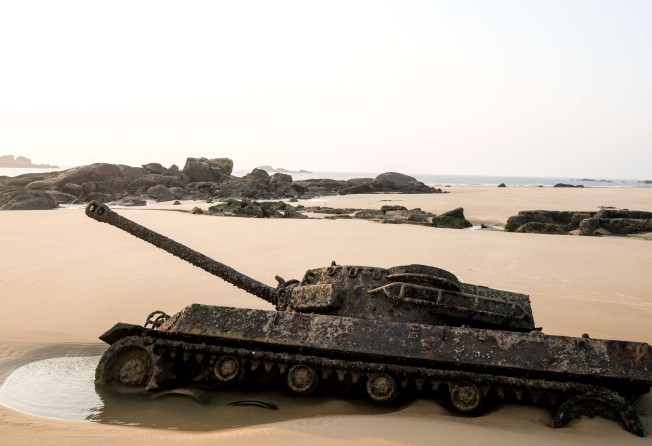
Taiwan’s cold war island begins to thaw
Kinmen, just 2km from the Chinese mainland, has been on the front line of cross-strait tensions since 1949. Now, along with the light from the shimmering skyscrapers on the horizon, some warmth is beginning to shine through

Mounds of sand sit beneath a row of pile drivers on Dadeng Island, where the Chinese city of Xiamen ( 廈門 ) is building a new airport on reclaimed land.
Syril Hung sighs, awestruck. The retired editor is looking through binoculars from Kinmen, a nearby island that belongs to Taiwan. On a clear day like this, sand-dredging barges can be seen working non-stop in the 2km stretch of water separating the two. “My heart is heavy,” he says. “It feels like they are getting closer and closer. This is the sadness of living next to a big country.”
For decades, Kinmen has grappled with being the part of Taiwan closest to mainland China; nearer than it is to Taiwan. It is a 30-minute ferry ride from the mainland, but an hour’s flight from Taipei.
Kinmen, all of 153 sq km, has long been on the front line of cross-strait tensions that this week led to Taipei scrambling jets and navy vessels to monitor a Chinese aircraft carrier group in the Taiwan Strait.

It bore the brunt of bloody battles in October 1949 when the Nationalist Kuomintang (KMT) soldiers based in Taiwan beat back the Communist People’s Liberation Army, keeping the island in KMT hands.
In later years, it was a military base where Taiwanese leader Chiang Kai-shek stationed much of his army to retake the mainland. Kinmen suffered numerous small incursions, 20 years of shelling by the mainland, and decades of direct military rule (1949-1992) from Taiwan. During a six-week artillery barrage in 1958, 500,000 rounds of mortar rained down on its tiny landmass.

At the height of the cold war, it was seen as a front line. The United States moved its warships into the Taiwan Strait in 1950 to prevent the Communists from invading. Over the past decade, however, relations have relaxed, with ferries plying the strip between Kinmen and Xiamen every half hour. In an unspoken arrangement to keep those waters calm, ferries from each side lower their flags at the halfway mark.
But proximity continues to create discomforts. Mainland China is so close its smog blows over to Kinmen, which has almost no industry but now experiences grey skies and poor air. On bad days, Kinmen residents complain about pollution and the influx of mainland tourists who have become a key driver of the local economy. Other residents yearn for more tourists, investment, and the completion of a long-discussed bridge linking Kinmen to the mainland.
Locals and politicians speak of the sacrifices Kinmen has had to endure because of its role as the front line, missing out on the decades of development that much of the rest of Taiwan experienced.

Kinmen islanders tend to be less Beijing-sceptic than people on the island of Taiwan 160km away. Locals see the looming presence of mainland China on their shores, and even under the recently elected pro-independence Democratic Progressive Party, there is little to hold back ever-closer ties. Kinmen has evolved from being a military frontline to being a test site for cross-strait political experiments. It is where Mainland-Taiwan postal and transport connections were first offered and now there’s an annual swim across the strait over which bombs were once lobbed. Kinmen is to get water piped from Fujian ( 福建 ) province soon.
But traces of tension are never far from the surface. There is a maze of tunnels for villagers to hide in during air raids and, while the presence of Taiwanese soldiers has dropped from 100,000 in the 1950s to 3,000 now, old military vehicles, bunkers, forts, and shells litter the island, evoking a time and tension past. At low tide on the northwest coast where some of the worst battles took place in 1949, barnacle-covered iron spikes pierce the sand, placed there to deter “water ghost” commandos from mainland China. But whether at low or high tide, on the horizon Xiamen’s growing skyline is in clear sight.
As a fishermen tugs at his nets early one morning, a ferry speeds past behind him, heading towards the shimmering skyscrapers on the other side. ■